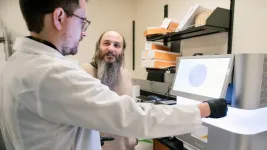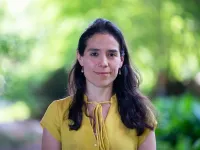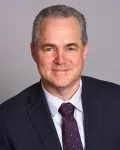American Geophysical Union
17 September 2024
AGU Release 24-33
For Immediate Release
This press release is available online at: https://news.agu.org/press-release/slow-landslides-growing-threat-mountain-communities/
Slow-moving landslides a growing, but ignored, threat to mountain communities
Urban growth, climate change, and flood risk at lower elevations can push people to live on steeper, more dangerous terrain
AGU press contact:
Rebecca Dzombak, news@agu.org (UTC-4 hours)
Potsdam press contact:
Stefanie Mikulla, University of Potsdam, presse@uni-potsdam.de (UTC+2 hours)
Researcher contact:
Joaquin Vicente Ferrer, University of Potsdam, +49 331 977-6257, ferrer@uni-potsdam.de (UTC+2 hours)
Interview requests should be directed to JV Ferrer
WASHINGTON — As urban centers in mountainous regions grow, more people are driven to build on steeper slopes prone to slow-moving landslides, a new study finds. Slow-moving landslides are frequently excluded from estimates of landslide risk, but they could threaten hundreds of thousands of people globally, the researchers conclude.
Slow-moving landslides can move as little as one millimeter per year and up to three meters per year. Slopes with slow-moving landslides may seem safe to settle on; the slide itself may be inconspicuous or undetected altogether.
As the slide creeps along, houses and other infrastructure can be damaged. The slow slide can accelerate abruptly, likely in response to changes in precipitation. Sudden acceleration can worsen damage and, in rare cases, lead to fatalities.
Those same slopes may be repopulated years later due to pressure from urban growth, especially when floods drive people from lower-elevation areas. Nearly 1.3 billion people live in mountainous regions, according to the IPCC, and that number is growing.
“As people migrate uphill and establish settlements on unstable slopes, a rapidly rising population is facing an unknown degree of exposure to slow landslides — having the ground move underneath their houses,” said Joaquin Vicente Ferrer, a natural hazards researcher at the University of Potsdam and lead author of the study.
The study presents the first global assessment of exposure to slow-moving landslides, which are left out of most assessments of populations exposed to landslide risk. It was published in Earth's Future, which publishes interdisciplinary research on the past, present and future of our planet and its inhabitants.
Finding slow-moving landslides
Through landslide mapping and inventory efforts, the authors compiled a new database of 7,764 large slow-moving landslides with areas of at least 0.1 square kilometers (about 25 acres) located in regions classified as “mountain risk” by the Intergovernmental Panel on Climate Change. Using this database, they explored regional and global drivers of exposure using statistical models.
Of the landslides documented, 563 — about 7% — are inhabited by hundreds of thousands of people. The densest settlements on slow-moving landslides were in northwestern South America and southeastern Africa. Central Asia, northeast Africa, and the Tibetan Plateau had the largest settlements exposed to slow-moving landslides. West-central Asia, and the Alai Range of Kyrgyzstan in particular, also had a high number of inhabited slow-moving landslides.
The study only looked at permanent settlements, so nomadic and refugee settlements were not included.
In all regions in the study, urban center expansion was associated with an increase in exposure to slow-moving landslides. As a city’s footprint expands, new growth may be forced to occur in unsafe areas, including slopes with known slow-moving landslides. But poorer populations may have few other options, the authors point out.
Flooding and future climates
Ties between climatic drivers and slow-moving landslide activation remain uncertain, but in general, scientists think intense precipitation and swings from dry to wet conditions can trigger an acceleration in slow-moving landslides. Those factors can also increase flooding, which in turn may drive people to move to higher ground.
The study found that populations facing increased flooding tended to have more settlements on slow-moving landslides. The strength of that relationship varied regionally; western North America and southeast Africa had the strongest associations.
The study also highlighted a lack of information in poor regions with known landslide risks, such as in the Hindu-Kush Himalayas, and called for more landslide detection and mapping to improve understanding of risks in those areas.
“We highlight a need to ramp-up mapping and monitoring efforts for slow-moving landslides in the East African Rift, Hindu-Kush-Himalayas, and South American Andes to better understand what drives exposure,” Ferrer said. “Despite a limited number of landslide inventories from Africa and South America, we found communities in cities are densely inhabiting slow-moving landslides there.”
Even in areas with good landslide mapping, such as northern North America (i.e., Canada and Alaska) and New Zealand, settlements are located on slow-moving landslides. While these weren’t included in the study, they remain important to consider, the authors said.
“Our study offers findings from a new global database of large slow-moving landslides to provide the first global estimation of slow-moving landslide exposure,” Ferrer said. “With our methods, we quantify the underlying uncertainties amid disparate levels of monitoring and accessible landslide knowledge.”
###
Notes for journalists:
This study is published in Earth’s Future, an open-access, peer-reviewed AGU journal. Neither this press release nor the study is under embargo. View and download a pdf of the study here.
Paper title:
“Human settlement pressure drives slow‐moving landslide exposure”
Authors:
Joaquin V. Ferrer (corresponding author); Institute of Environmental Sciences and Geography, University of Potsdam, Potsdam-Golm, Germany; Potsdam Institute for Climate Impact Research, Potsdam, Germany
Guilherme Samprogna Mohor, Oliver Korup, Annegret H. Thieken, Institute of Environmental Sciences and Geography, University of Potsdam, Potsdam-Golm, Germany
Olivier Dewitte, Department of Earth Sciences, Royal Museum for Central Africa, Tervuren, Belgium
Tomas Panek, Department of Physical Geography and Geoecology, University of Ostrava, Ostrava, Czech Republic
Cristina Reyes-Carmona, Department of Earth and Environmental Sciences, University of Milano-Bicocca, Milan, Italy; Department of Civil Engineering, University of Alicante, Alicante, Spain
Alexander L. Handwerger, Jet Propulsion Laboratory, California Institute of Technology, Pasadena, USA; Joint Institute for Regional Earth System Science and Engineering, University of California, Los Angeles, Los Angeles, USA
Marcel Hurlimann, Department of Civil and Environmental Engineering, UPC BarcelonaTECH, Barcelona, Spain
Lisa Kohler, Institute of Environmental Sciences and Geography, University of Potsdam, Potsdam-Golm, Germany; Department of Urban and Environmental Sociology, Helmholtz-Centre for Environmental Research-UFZ Leipzig, Leipzig, Germany
Kanayim Teshebaeva, GFZ German Research Center for Geosciences, Potsdam, Germany
Ching-Ying Tsou, Faculty of Agriculture and Life Science, Hirosaki University, Hirosaki, Japan
Alexandra Urgilez Vinueza, Water Management Department, Delft University of Technology, Delft, Netherlands
Valentino Demurtas, Department of Chemical and Geological Sciences, University of Cagliari, Monserrato, Italy
Yi Zhang, School of Earth Sciences, Lanzhou University, Lanzhou, China
Chaoying Zhao, School of Geological Engineering and Geomatics, Chang’an University, Chang’an, China
Norbert Marwan, Jurgen Kurths, Potsdam Institute for Climate Impact Research, Potsdam, Germany
###
AGU (www.agu.org) is a global community supporting more than half a million advocates and professionals in Earth and space sciences. Through broad and inclusive partnerships, AGU aims to advance discovery and solution science that accelerate knowledge and create solutions that are ethical, unbiased and respectful of communities and their values. Our programs include serving as a scholarly publisher, convening virtual and in-person events and providing career support. We live our values in everything we do, such as our net zero energy renovated building in Washington, D.C. and our Ethics and Equity Center, which fosters a diverse and inclusive geoscience community to ensure responsible conduct.
END





